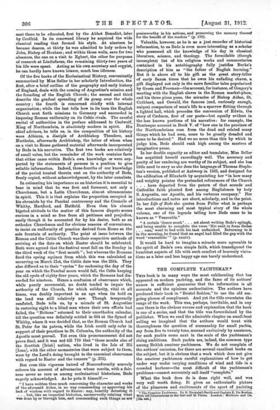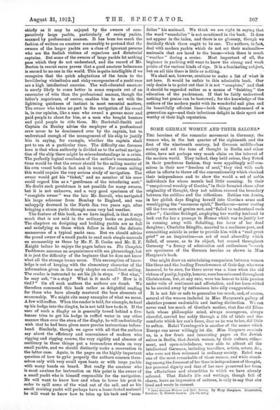THE COMPLETE YACHTSMAN.*
Tuts book is in many ways the most exhilarating that has appeared on modern yachting, and the fame of its authors' names is sufficient guarantee that the information is all accurate and the opinions authoritative. The authors have produced their book in " Bristol fashion," to use the old sea- going phrase of compliment. And yet the title overstates the range of the work. This was, perhaps, inevitable, and in any case there is the obvious excuse and explanation that the book is one of a series, and that the title was foreordained by the publisher. When we read the admirable chapter on small-boat sailing we imagined that the authors would treat with thoroughness the question of seamanship for small yachts, say from five to twenty tons, manned exclusively by amateurs, for such yachts come next in the scale of the yachtsman's rising ambitions. Such yachts are, indeed, the common type among British amateur yachtsmen. We do not complain of the authors' omission, for there are several excellent books on the subject, but it is obvious that a work which does not give the amateur yachtsman careful explanations of how to get under way under varying conditions of wind and tide in a crowded harbour—the most difficult of the yachtsman's problems—cannot accurately call itself "complete."
What the book does do is done right well, and was very well worth doing. It gives an enthusiastic picture of the pleasures and excitements of the sport of yachting
• The Complete Yachtsman. By B. Ifeekstall-Smith and Captain E. Du Boaliy. With 400 Illustrations in the text and 2& Plates. London : Methuen and Co. f_358. net.] chiefly as it may be enjoyed by the owners of corn- piratively large yachts, particularly of racing yaehts, manned by professional seamen. It has been too much the fashion of writers on amateur seamanship to pretend that the owners of the larger yachts are a class of ignorant persons who are the foolish victims of rapacious and dictatorial captains. But some of the owners of large yachts let nothing pass which they do not understand, and the record of Mr. Burton in recent races proves that a good amateur helmsman is second to no one in the world. This is quite intelligible if we recognize that the quick adaptations of the brain to the bewildering vicissitudes and risky emergencies of a yacht race are a high intellectual exercise. The well-educated amateur is surely likely to come better in some respects out of an encounter of wits than the professional seaman, though the latter's experience, of course, enables him to act with the lightning quickness of instinct in most essential matters. The owner who takes no part in the navigation of his vessel is, in our opinion, like a man who owned a groute moor and paid people to shoot for him, or a man who bought hunters and paid people to ride them. Mr. Heckstall-Smith and Captain du Boulay advise the employer of a professional crew never to be domineered over by the captain, but to understand enough of the management of his ship to justify LIM in saying, for example, whether the captain shall put to sea at a particular time. The difficulty one foresees here is that when authority is divided as to the actual naviga- tion of the ship there might be misunderstandings in a crisis. The perfectly logical conclusion of the author's recommenda- tions would be that the owner should be the sailing master of his own vessel both in fact and in name. For ocean sailing this would require the very serious study of navigation. The owner would get his "ticket," and no member of his crew could regard him as a a gentleman of the interfering sort." No doubt such persistence is not possible for many owners, but it is not unknown, and a very good specimen of the "complete owner" was the late Mr. Scovell, who navigated his large schooner from Bombay to England, and was unhappily drowned in the North Sea two years ago, after bringing a steam yacht through some very bad weather. The feature of this book, as we have implied, is that it says much that is not said in the ordinary books on yachting. The chapters on designing and building yachts are as full and satisfying as these which follow in detail the delicate manmuvres of a typical yacht race. But we should advise the proud owner of a small yacht to read such simple manuals on seamanship as those by Mr. F. B. Cooke and Mr. E. F. Knight before he enjoys the pages before us. The Complete Yachtsman assumes an acquaintance with sea phraseology, but it is just the difficulty of the beginner that he does not know what all the strange terms mean. This assumption of know- ledge is out of keeping with the elementary character of the information given in the early chapter on small-boat sailing. The reader is instructed to set his jib in stops. " But what," he may ask, " is a stop ? What is it made of ? How is it tied P " On all such matters the authors are dumb. We therefore commend this book rather as delightful reading for those who have already mastered the bare elements of seamanship. We might cite many examples of what we mean. A few will suffice. When the reader is told, for example, to haul up his kedge into the dinghy, he is not told how to do it If the user of -such a dinghy as is generally towed behind a flve- tonner tries to get his kedge in ruffled water in any other manner than over the stern of the dinghy, he will undoubtedly wish that he had been given more precise instructions before- hand. Similarly, though we agree with all that the authors say about the efficiency and convenience of modern wire rigging and rigging screws, the very rigidity and absence of resiliency in these things put a tremendous strain on very small yachts, and we should distinctly make a reservation in the latter case. Again, in the pages on the highly important question of how to gybe properly the authors concern them- selves only with very small open boats or with large yachts with many hands on board. But really the amateur who is most anxious for instruction on this point is the owner of a small yacht who is himself responsible for the navigation. He will want to know how and when to lower his peak in order to spill some of the wind out of the sail, and as his small cruising yacht will perhaps have a loose-footed mainsail he will want to know how to trice up his tack and " scan-
dalize " his mainsail. We think we are right in saying that the word "scandalize " is notmentioned in the book. It does not appear in the index, and there is no glossary, though we decidedly think there ought to be'one. The Authors, in fact, deal with modern yachts which do not set their mainsails-e mainsails that are 'seed to the booma-when there is much "weather " during a cruise. Most important of all, the beginner in yachting will want to know the strong and weak points of the various kinds of rigs. It is a faiciitating subject,' but on all this there is little or nothing.
We shall not, however, continue to make a list of what^ is not here. It would be unfair to this admirable book, -Our only desire is to point out that it is not " complete," and that it should be regarded rather as a, means of " Bniabing"• the education of the yachtsman. If that be fairly understood nothing but praise- can be bestowed; for the knowledge of the authors of the modern yacht with its wonderful sail plan and its beautifully efficient lines—both things undreamed of a generation ago—and their infectious delight in their sport are worthy of their high reputation.



































 Previous page
Previous page